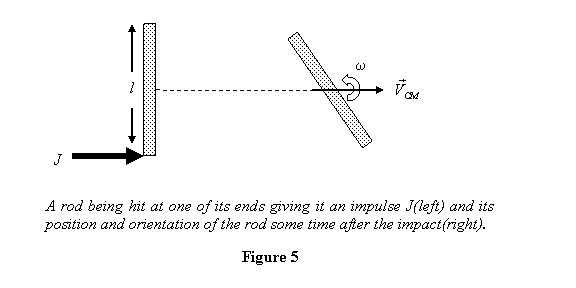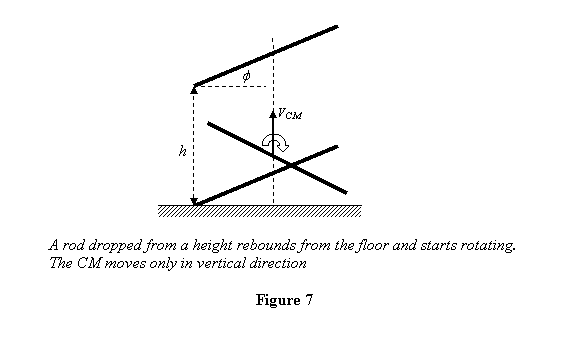Example
1: A uniform rod of mass m and
length l is on a smooth horizontal
table (friction = 0) and is hit at one of its
ends so that an impulse J is imparted
to it in its perpendicular direction (see figure
5). What is its subsequent motion?

As the rod is hit, its CM will start moving with a velocity

At the same time the rod also starts rotating. Although
the CM will be accelerating during the impact, we can
apply the angular momentum-torque equation about it with
only external torque in the equation. If the angular
speed of the rod after the impact is ω, it is given
by

Note that in the sentence above, I have said 'angular
speed of the rod' and not 'angular speed of the rod about
the CM because the sense and amount of rotation about
any point in the body is the same, as was discussed in
a previous lecture. The position and orientation of the
rod some time after the impact is also shown in figure
5.
Example 2: A wheel of mass m and radius
R is sliding on a smooth surface (No rolling) with speed
V. It then hits a very rough surface so that it starts
rolling (see figure 6). What is it rolling speed?

Let the rolling speed of the wheel be V1 . As
soon as the wheel hits the rough surface, it gets an
impulse J at its point on the surface in the direction
opposite to its velocity. This reduces its speed and
also makes it rotate. It rolls if the speed V1 of
its CM is equal to ωR , where ω is
the rolling speed it gains after hitting the rough surface.
The change in the CM speed is given by

Applying the angular-momentum torque equation about the
CM, we get

With the condition of rolling,  ,
the above two equations give ,
the above two equations give

I would like you to repeat the same exercise for a disc.
The problem can also be solved by applying conservation
of the point of impact on ground, because the impulse
gives zero torque about that point. The initial angular
momentum of the wheel with respect to that point is mVR .
The final angular momentum is (angular momentum of the
CM plus angular momentum about the CM). This comes out
to be (mV1R + mR2ω) .
Equating this to mVR and using the rolling condition
gives the same answer as above. A warning: keep in mind
that the torque is being taken with respect to the point
on ground and not the point on the wheel that is touching
the ground. Doing that will not be correct because at
the time of impact the point on the wheel is accelerating
in the direction opposite to  . .
I now solve a problem that involves, in addition to the
equations above, energy conservation also.
Example 3: A rod of mass m and
length l is held making an angle Φ from
the horizontal at a height h from the floor
(see figure 7). When dropped from rest, what will be
its linear and angular speed after it rebounds from the
floor? Assume no energy is lost during the impact with
the floor.

When the rod hits the floor, it receives an impulse J from
the ground in the vertically up direction. Although the
rod is also being acted upon by its weight, we neglect
its effect during impact (see discussion in the lecture
on momentum). Since all the forces are in the vertical
direction, the CM of the rod also moves only vertically.
Before hitting the floor, the speed of the CM is  and
the angular speed of the rod is zero. Let the rebound
speed of the CM be V and the angular speed
of the rod after rebounding be ω. Then similar
to the example above, these quantities are related as
(keep in mind that we are dealing with vector quantities
so their signs have to be properly accounted for) and
the angular speed of the rod is zero. Let the rebound
speed of the CM be V and the angular speed
of the rod after rebounding be ω. Then similar
to the example above, these quantities are related as
(keep in mind that we are dealing with vector quantities
so their signs have to be properly accounted for)

These are two equations for three unknowns: V, ω and J.
We therefore need one more equation. This is provided
by energy conservation. We express the kinetic energy
of the rod after it rebounds as the sum of the kinetic
energy of its CM and the kinetic energy about its CM.
Thus immediately after the impact, energy conservation
gives

Now we have three equations that can be solved for the
three unknowns. This is left for you to do.
Question you might now ask is if we could use the principle
angular momentum and energy conservation directly to
solve this problem in a manner similar to what we did
at the end of the last example. We would like to apply
the conservation of angular momentum about the point
of impact on the ground because torque due to the impulse
about this point vanishes. Although there is another
external force - the weight of the rod - acting on the
system, its effect during the impact can be ignored because
very short duration of impact. Thus we can say that the
angular momentum about the point of impact is conserved.
This gives (left as an exercise for you)

This is the same equation that is obtained by combining
the first two equations above. Thus we obtain the same
answer by this method also.
I end this lecture by giving you an exercise.
Exercise: A disc of mass m and radius
R is made to roll on a rough surface by applying a force
F at its centre. If it does not slip on the floor, i.e.
it does pure rolling, find its acceleration by applying
methods developed in this lecture.
|